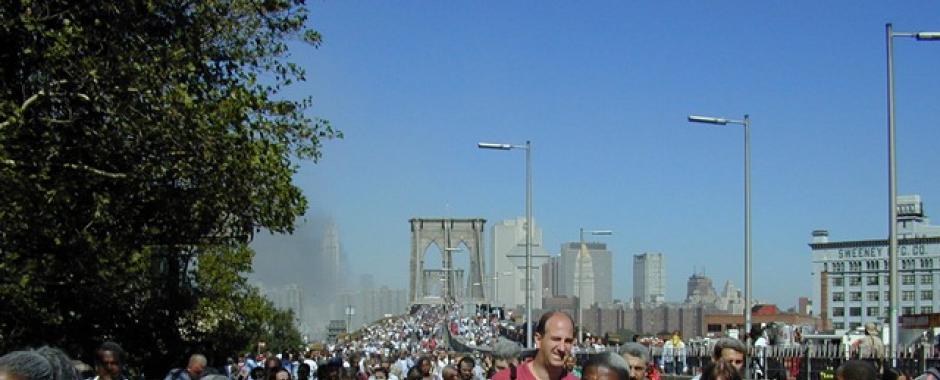Eran las 8 y algo de la mañana, encendí el televisor, desayuné, y minutos después fui a afeitarme. Algo me llamó la atención, regresé a la sala y subí el volumen de mi pequeña televisión de segunda mano. En la pantalla aparecía el rótulo de “America under attack” sobre la imagen de un avión estrellándose contra una de las “torres gemelas” del World Trade Center de Nueva York. No comprendía nada. Al principio creí que se trataba del trailer de una nueva superproducción cinematográfica de Hollywood. Pero algo no encajaba. El periodista continuaba insistiendo en la noticia. Algo estaba pasando y el nerviosismo del locutor pronto traspasó la pantalla. Los minutos transcurrían, y de repente un segundo avión cruzó el cielo en dirección a la segunda torre… explosiones, humo, fuego…pánico…las torres empezaron a derrumbarse como castillos de arena ante una galerna…la televisión hablaba de otros aviones… ¿Qué estaba ocurriendo? ¿Quién estaba atacando a Estados Unidos?
Salí de casa hacia la universidad. En la vieja biblioteca de la Universidad de Nevada, Reno, Getchell Library, donde se ubicaba el Centro de Estudios Vascos, habían dispuesto un número de televisores alrededor de los cuales la gente se arremolinaba en el más completo silencio. Algunos estudiantes lloraban histéricos, mientras otros intentaban consolarles. Queríamos comprender lo que estaba pasando pero estaba fuera de toda comprensión. Las noticias no aclaraban nada y todos los canales repetían constantemente la imagen del derrumbe de las torres gemelas. Día tras día, noche tras noche, las 24 horas del día, las mismas imágenes… Solamente el paso del tiempo nos ofreció una explicación más nítida de lo que ocurrió esa mañana del 11 de Septiembre de 2001. Por el momento todo era confusión y caos.
Al mediodía, irónicamente, teníamos programado hablar de “terrorismo” y “violencia política” en la clase que impartía Joseba Zulaika, Director del Centro de Estudios Vascos. Obviamente no era el momento más propicio para abordar dicho tema. En esta terrible situación, Zulaika propuso a los alumnos, visiblemente afectados, la posibilidad de hablar sobre los trágicos acontecimientos ocurridos unas pocas horas antes. Fue una clase memorable. La palabra se convirtió en un bálsamo que catalizaba angustias y temores. Nos apaciguó.
 (Imagen: National September 11 Memorial & Museum)
(Imagen: National September 11 Memorial & Museum)
Medios de comunicación (New York Times), bibliotecas públicas (Library of Congress), programas universitarios de Historia Oral (Columbia University), y departamentos de Psicología de todo el país no tardaron mucho en empezar a recoger miles de testimonios directos e indirectos sobre el “11 S”. Los objetivos eran ofrecer una ayuda directa a las personas más afectadas por los sucesos a la vez que preservar la memoria de los testigos directos de aquel desgraciado hecho histórico. El proceso de duelo colectivo de la sociedad estadounidense había comenzado. La memoria y el recuerdo se transformaron en los ejes de vertebración de la post-América del 11 de Septiembre. “Nunca olvidaremos” (“We will never forget”) se convirtió en el nuevo lema americano.
Sin embargo, las palabras no fueron suficientes para contrarrestar la inseguridad de la población. Las acciones recobraron protagonismo y la retórica bélica se impuso al discurso de la reconciliación. El periodista norteamericano John Carlin escribía hace unos días sobre las desastrosas consecuencias que trajo consigo las medidas “preventivas” que el gobierno de Estados Unidos puso en marcha en respuesta a los atentados del 11 de Septiembre. Carlin estimaba que hasta la fecha las guerras en Afganistán e Irak habían provocado entre 250.000 y 1 millón de víctimas mortales con un gasto cercano a los 4 billones de dólares. Uno no puede más que preguntarse por los horrores de los que habrán sido testigos los habitantes de ambos países.
Y tú ¿dónde estabas el 11 de Septiembre?

